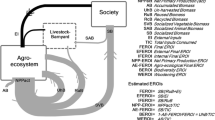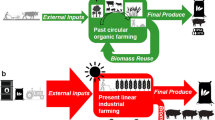Abstract
This article presents an energy analysis of Quebec agroecoystems at five periods of time: 1871, 1931, 1951, 1981, and 2011, calculating for each year the various energy flows and their resulting Energy Return on Investment (EROI). In the nineteenth century, Quebec agroecosystems were typical examples of historical organic agriculture, with a low dependence on external Inputs but a high dependence on biomass reused, mainly livestock feed and crop seeds. Following the full industrialization of Quebec agriculture by the 1960s, there have been massive injections of external inputs, but also steadily rising amounts of biomass reused due to livestock specialization and the decoupling of domesticated animals from crop farming. As a result of this transformation, the energy efficiency of agroecosystems diminished, despite the significant increases in both final produce and area productivity that were achieved.



Similar content being viewed by others
Notes
According to the censuses of agriculture in Canada, improved land is defined as the farmland that has been transformed by the settler for agrarian uses. It includes cropland, fallow area, improved pasture land, and other improved area (the area of barnyards, lanes and roads on farms, and idle cultivated areas). This process of clearing the land could take years or decades (Linteau et al. 1983). On the other hand, the non-improved land is defined as an area inside the farm that has not been transformed and used by the farmer for agrarian use. It includes woodland, natural pasture, and other non-improved land (uncultivated hay land, brush pasture, grazing or waste land, sloughs, marsh, and rocky land).
References
Acton DF, Gregorich LJ (1995) The health of our soils—towards sustainable agriculture in Canada. Centre for Land and Biological Resources Research, Research Branch, Agriculture and Agri-Food Canada, Ottawa
Aguilera A, Guzmán GI, Infante-Amate J, Soto D, García-Ruiz R, Herrera A, Villa I, Torremocha E, Carranza G, González de Molina M (2015) Embodied energy in agricultural inputs. Incorporating a historical perspective. Working Paper of the Sociedad Española de Historia Agraria DT-SEHA 1507. http://hdl.handle.net/10234/141278. Accessed 29 January 2018
Boudreau C, Courville S, Séguin N (1997) Atlas historique du Québec. Le territoire. Les presses de l'Université Laval, Sainte-Foy
Courville S, Robert JC, Séguin N (1995) Atlas historique du Québec. Le pays laurentien au XIXe siècle. Les presses de l'Université Laval, Sainte-Foy
Courville S (2000) Le Québec. Genèse et mutations du territoire. Les Presses de l’Université Laval, Sainte-Foy
Cunfer G (2004) Manure matters on the Great Plains frontier. J Interdiscip Hist 34:539–567. https://doi.org/10.1162/002219504773512534
Dupras J, Marull J, Parcerisas L, Coll F, Gonzalez A, Girard M, Tello E (2016) The impacts of urban sprawl on ecological connectivity in the Montreal metropolitan region. Environ Sci Pol 58:61–73. https://doi.org/10.1016/j.envsci.2016.01.005
Dyer JA, Desjardins RL (2006) An integrated index of electrical energy use in Canadian agriculture with implications for greenhouse gas emissions. Biosyst Eng 95:449–460. https://doi.org/10.1016/j.biosystemseng.2006.07.013
Eilers W, MacKay R, Graham L, Lefebvre A (2010) Environmental sustainability of Canadian agriculture: Agri-environmental IndicatorReport series — report #3. Agriculture and Agri-Food Canada, Ottawa
FAO (2006) World agriculture towards 2030–2050. Prospects for food, nutrition. Agriculture and Major Commodity Groups. FAO, Rome
Fédération des producteurs forestiers du Québec (2016) La forêt privée chiffrée. http://www.foretprivee.ca/wp-content/uploads/2012/02/La-foret-privee-chiffree-2016.pdf. Accessed 29 January 2018
Federico G (2005) Feeding the world: an economic history of agriculture, 1800–2000. Princeton University Press, Princeton
Fischer-Kowalski M, Haberl H (2007) Socioecological transitions and global change: trajectories of social metabolism and land use. Edward Elgar, Cheltenham
Giroux I (2003) Contamination de l’eau souterraine par les pesticides et les nitrates dans les régions en culture de pommes de terre. Direction du suivi de l’état del’environnement. Ministère de l’Environnement, Québec http://www.mddelcc.gouv.qc.ca/pesticides/pomme_terre/Pesticides_pomme_terre.pdf. Accessed 29 January 2018
González de Molina M, Toledo VM (2014) The social metabolism. A socio-ecological theory of historical change. Springer, New York
Grigg D (1992) The transformation of agriculture in the west. Blackwell Pub, Oxford
Guzmán GI, González de Molina M (2009) Preindustrial agriculture versus organic agriculture: the land cost of sustainability. Land Use Policy 26:502–510. https://doi.org/10.1016/j.landusepol.2008.07.004
Guzmán G, Aguilera E, Soto D, Cid A, Infante-Amate J, García-Ruiz R, Herrera A, Villa I, González de Molina M (2014) Methodology and conversion factors to estimate the net primary productivity of historical and contemporary agroecosystems. Working papers SEHA, 14–07. http://repositori.uji.es/xmlui/handle/10234/91670. Accessed 29 January 2018
Guzmán GI, González de Molina M (2015) Energy efficiency in agrarian systems from an agro-ecological perspective. Agroecol Sustain Food Syst 39:924–952. https://doi.org/10.1080/21683565.2015.1053587
Hayes D (2015) Historical atlas of Canada: Canada’s history illustrated with original maps. Douglas & McIntyre, British Columbia
Jobin B, Latendresse C, Grenier M, Maisonneuve C, Sebbane A (2010) Recent landscape change at the ecoregion scale in southern Québec (Canada), 1993–2001. Environ Monit Assess 164:631–647. https://doi.org/10.1007/s10661-009-0918-5
Jobin B, Latendresse C, Baril A, Maisonneuve C, Boutin C, Côté D (2014) A half-century analysis of landscape dynamics in southern Québec, Canada. Environ Monit Assess 186:2215–2229. https://doi.org/10.1007/s10661-013-3531-6
Kastner T, Kastner M, Nonhebel S (2011) Tracing distant environmental impacts of agricultural products from a consumer perspective. Ecol Econ 7:1032–1040. https://doi.org/10.1016/j.ecolecon.2011.01.012
Krausmann F (2004) Milk, manure, and muscle power. Livestock and the transformation of preindustrial agriculture in central Europe. Hum Ecol 32:35–772. https://doi.org/10.1007/s10745-004-6834-y
Krausmann F, Schandl H, Sieferle RP (2008) Socio-ecological regime transitions in Austria and the United Kingdom. Ecol Econ 65:187–201. https://doi.org/10.1016/j.ecolecon.2007.06.009
Krausmann F, Erb KH, Gingrich S, Haberl H, Bondeau A, Gaube V, Lauk C, Plutzar C, Searchinger TD (2013) Global human appropriation of net primary production doubled in the 20th century. PNAS 110:10324–10329. https://doi.org/10.1073/pnas.1211349110
Levallois P, Theriault UM, Rouffignat J, Tessier S, Landry R, Ayottea P, Girard M, Gingras S, Gauvin D, Chiassone C (1998) Groundwater contamination by nitrates associated with intensive potato culture in Quebec. Sci Total Environ 217:91–101. https://doi.org/10.1016/S0048-9697(98)00191-0
Linteau PA, Durocher R, Robert JC (1983) Quebec: a history 1867–1929. James Lorimer & Company, Toronto
Mazoyer M, Roudart L (2006) A history of world agriculture: from the Neolithic age to the current crisis. Monthly Review Press, New York
Paquette S, Domon G (1997) The transformation of the agroforestry landscape in the nineteenth century: a case study in southern Quebec (Canada). Landsc Urban Plan 37:197–209. https://doi.org/10.1016/S0169-2046(97)80004-7
Paquette S, Domon G (2001) Trends in rural landscape development and sociodemographic recomposition in southern Quebec (Canada). Landsc Urban Plan 55:215–238. https://doi.org/10.1016/S0169-2046(01)00154-2
Pelletier N, Arsenault N, Tyedmers P (2008) Scenario modeling potential eco-efficiency gains from a transition to organic agriculture: life cycle perspectives on Canadian canola, corn, soy, and wheat production. Environ Manag 42:989–1001. https://doi.org/10.1007/s00267-008-9155-x
Pelletier N, Audsley E, Brodt S, Garnett T, Henriksson P, Kendall A, Kramer K, Murphy D, Nemecek T, Troell M (2011) Energy intensity of agriculture and food systems. Annu Rev Environ Resour 36:223–246. https://doi.org/10.1146/annurev-environ-081710-161014
Petit HV (1993) Pasture management and animal production in Quebec. Can J Anim Sci 73:715–724. https://doi.org/10.4141/cjas93-077
Pimentel D, Hepperly P, Hanson J, Douds D, Seidel R (2005) Environmental, energetic and economics comparisons of organic and conventional farming systems. Bioscience 55:573–582. https://doi.org/10.1641/0006-3568(2005)055[0573:EEAECO]2.0.CO;2
Pimentel D (2009) Environmental and economic costs of the application of pesticides primarily in the United States. In: Peshin R, Dhawan A (eds) Integrated Pest management: innovation-development process. Springer, Netherlands, pp 89–111
Russell PA (2012) How agriculture made Canada. Farming in the nineteenth century. McGill-Queen's University Press, Montreal
Statistics Canada (1872) Census of Canada 1870–1871, vol 1. Statistics Canada, Ottawa
Statistics Canada (1935) Seventh census of Canada, 1931. Quebec, census of agriculture. Statistics Canada, Ottawa
Statistics Canada (1953) Ninth census of Canada, 1951. Volume VI, agriculture. Statistics Canada, Ottawa
Statistics Canada (1982) 1981 census of Canada, agriculture, Quebec. Statistics Canada, Ottawa
Statistics Canada (2012) 2011 census of agriculture. Statistics Canada, Ottawa
Tello E, Cattaneo C (2017) The energy trap of the green revolution. Energy profiles of past and present farm systems from a comparative perspective. 12th Conference of the European Society for Ecological Economics, 20–23 June, 2017, Budapest
Tello E, Galán E, Cunfer G, Guzmán GI, González de Molina M, Krausmann F, Gingrich S, Marco I, Padró R, Sacristán V, Moreno-Delgado D (2015) A proposal for a workable analysis of Energy Return On Investment (EROI) in agroecosystems. Social Ecology Working Paper 156. https://www.aau.at/wp-content/uploads/2016/11/working-paper-156-web.pdf. Accessed on 29 January 2018
Tello E, Jover G (2014) Economic history and the environment: new questions, approaches and methodologies for the environmental and economic history of pre-industrial and industrial societies. In: Agnoletti M, Neri S (eds) The basic environmental history. Springer International Publishing, Switzerland, pp 31–76
Tello E, Galán E, Sacristán V, Cunfer G, Guzmán GI, González de Molina M, Krausmann F, Gingrich S, Padró R, Marco I, Moreno-Delgado D (2016) Opening the black box of energy throughputs in farm systems: a decomposition analysis between the energy returns to external inputs, internal biomass reuses and total inputs consumed. Ecol Econ 121:160–174. https://doi.org/10.1016/j.ecolecon.2015.11.012
Van Bochove E, Thériault G, Dechmi F, Leclerc ML, Goussard N (2007) Indicator of risk of water contamination by phosphorus: temporal trends for the province of Quebec from 1981 to 2001. Can J Soil Sci 87:121–128. https://doi.org/10.4141/S06-067
Woods J, Williams A, Hughes JK, Black M, Murphy R (2010) Energy and the food system. Philos Trans R Soc B 365:2991–3006. https://doi.org/10.1098/rstb.2010.0172
Acknowledgements
This work has been supported by le Jour de la Terre Québec and arises from the international research project on Sustainable Farm Systems: Long-Term Socio-Ecological Metabolism in Western Agriculture funded by the Social Sciences and Humanities Research Council of Canada SFS 895-2011-1020. The authors are also extremely grateful to the help given by Enric Tello, Roc Padró, and Inés Marco in the construction of the EROIs.
Author information
Authors and Affiliations
Corresponding author
Electronic supplementary material
ESM 1
(DOCX 28 kb)
Rights and permissions
About this article
Cite this article
Parcerisas, L., Dupras, J. From mixed farming to intensive agriculture: energy profiles of agriculture in Quebec, Canada, 1871–2011. Reg Environ Change 18, 1047–1057 (2018). https://doi.org/10.1007/s10113-018-1305-y
Received:
Accepted:
Published:
Issue Date:
DOI: https://doi.org/10.1007/s10113-018-1305-y




